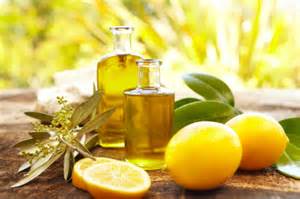









Aromapsychology 2
The expression 'chalk and cheese' comes to mind but essential oils are neither chalk or cheese - they are pure, luxurious, delightful, beneficial substances, desigined by a supreme force called nature. Synthetic fragrances, on the other hand, were designed by men in laboratories and their benefits (other than to satisfy commercial interests) have not yet being proved. Indeed, synthetics are not even meant to be beneficial to us. They're just designed to make us choose one particular product over another, and pay more for it.
The olfactory onslaught is already upon us. Personally I hate getting into the back of a taxi only to discover there is a horrible chemical air freshner on the shelf behind my head. The window has to be opened and I practically hold my breath until we get to where we we're going. And the massive aroma bombardment that comes from the most cosmetic sections in department stores is often overwhelming. But now we have a whole new dimension to aromaas the mind-altering effects of essential oils are being exploited in many so-called 'aromatherapy 'products, which you can find in all the major high street shops.
What happens is that research shows a particular essential oil is relaxing, neroli for examplw, so the toiletry manufacturers say 'let's make a relaxing neroli bubble-bath'. The next thing is you see products on the shelf purporting to be a 'relaxing aromatherapy' bubble bath, but what you don't know is that the product doesn't have a drop of neroli oil in it. Instead, it's got a combination of chemicals that smell like neroli.
Now, the chemists will tell you that it makes no difference. According to them, the chemical cocktails they produce in the lab and the real thing- neroli oil, say - are more or less the same thing . Some will even tell you that the chemical version is better! The logic goes like this: there are 100 components in neroli oil, say, but only 5 or 10 of these actually produce the smell, so those 5 or 10 can be tested for safety and combined to make a 'neroli' product. Real neroli, they say, cannot be tested for safety because it's too complex. Therefore the chemical 'copy' is safer than the real thing. This logic makes sense until you realize two things. First neroli oil, like all essential oils, is very complex - too complex to copy
.
No laboratory can produce a 'neroli' which does what a true neroli does - create well being, for example, because no body has yet discovered what all the minuscule components of neroli actually are . We don't have names for them. The chemists say you don't need the 90-95 other components of neroli - but this really depends on whether you're trying to replicate the smell or the effect. Second, it is one thing to test individually a group of chemicals for inclusion in a product and declare them safe, but waht about the product as a whole - how are those chemicals interacting with each other - and, more importantly, with all the natural chemicals, and with cells within our body?
Chemists are very fond of pointing out that within some essential oils there are tiny components which may be toxins, and that if they tried to reproduce them in a product, it wouldn't be allowed. Yes, maybe, but we're not making essential oils in a lab. The whole point about essential oils is that they are complex and work as a whole. There might be something in an essential oil which is toxic but the context of the whole oil in synergistic or antagonistic combination with all the other bits and pieces, it becomes non-toxic. It is this beautiful balance which gives them the extraordinary potency which cannot be replicated. James A Duke PhD, one of the world's foremost authorities on natural plant products makes another important point:
Through evolution our genes have already experienced many of the natural compounds, including toxic and medicinal compounds, often equipping us with mechanism to deal with reasonable doses of these toxins. Our genes have no experience with tomorrow's synthetics....Through maternal and/or cytoplasmic inheritance, our immune systems have also experienced many of the natural compounds, but not tomorrow's synthetics.
Today millions of people will apply essential oils to their bodies, in the form of perfume, and other millions will put them in their mouths in the form of drinks and food. Every time you chew a piece of spearmint or peppermint gum, essential oils are involved, while the soft drinks industry purchases by far the largest portion of citrus essential oils .
Even Ylang Ylang, usually just thought of just as a perfume ingredient, is used in confectionery and baking goods. Essential oils are a vast worldwide industry. For examplwe, in 1992 peppermint and spearmint oil production in America alone was worth $95 million and $46 million, respectively. Someone consumes all this and as far as anyone has ever been able to say, they have suffered no toxic side effects from it. Nor, as far as I am aware, has anyone suffered toxic side-effects from potatoes which, chemists are well aware, contain toxins - especially in the peel.
Reference: The Fragrant Pharmacy: V. A. Worwood
- Home
- Addiction
- JASMINE- Floral - Jasminum Officinale,J. grandiflorum, J.sambac
- History of Drugs-4
- History of Drugs
- History of Drugs-3
- The Somatid Connection
- Rosemary-Personality-Profile
- Personality In Perfumery
- Personality Tests
- Cinnamon - Personality profile
- The Water Connection
- Mind-Mood-Emotion-Quick Reference Chart - S - Un
- History of Drugs-5
- Mind-Mood-Emotion-Quick Reference Chart - Un - W
- Emotional-Healing Problems-A-B-Positive and Negative Mood Charts
- Emotional-Healing Problems-B-H-Positive and Negative Mood Charts
- How Essential Oils Work On the Brain
- Cardamom Personality Profile
- Essential Oils Used For Emotional Healing-A-M
- Lavender- Floral/Herbie
- Positive Mind, Mood & Emotion - Alertness
- Juniper personality profile
- JASMINE- Floral - Jasminum Officinale,J. grandiflorum, J.sambac
- HYACINTH - Floral - Hyacinthus Orientalis
- Emotional Healing Introduction - 2
- Emotional Healing Introduction
- Memory Enhancement, Mental Clarity and Efficiency
- How To Get Through Life In One Piece
- HELICHRYSUM (Immortelle or Italian Everlasting)
- GRAPEFRUIT - Fruitie - Citrus paradisi
- The Art Of Smelling - Which Method - Aromaprofiles
- The Art Of Smelling
- GINGER PERSONALITY PROFILE
- Geranium - Pelargonium graveolens Personality Profile
- Frankincense Resinie - Boswellia Carteri
- Quality and Purity - 2 - AromaProfiles
- Quality and Purity - AromaProfiles
- ChemoTypes - AromaProfiles
- Adaptogens - AromaProfiles



